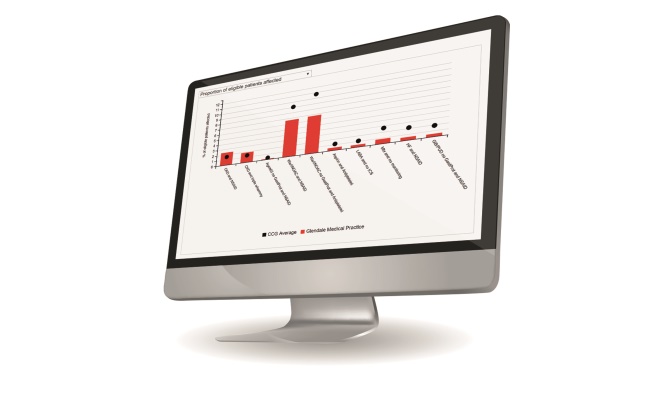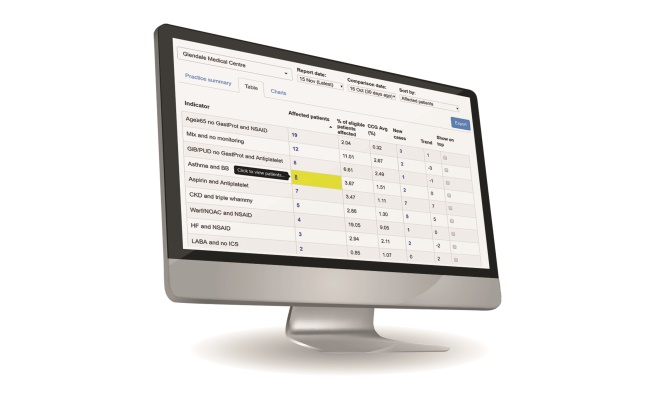
Shutterstock.com
It has been estimated that around 1 in 25 hospital admissions in the UK is the result of hazardous prescribing, contributing to 1,708 deaths per year[1]
[2]
[3]
. But GP pharmacists are at the epicentre of a major drive to tackle dangerous prescribing in the community and this is already saving lives.
The ‘Pharmacist-led Information Technology Intervention for Medication Errors’ — or PINCER — project has been tested by pharmacists in hundreds of GP practices in the East Midlands since 2015, and has now been given the green light for a nationwide rollout. Using a computer programme to pull out data from GP systems, pharmacists identify patients at potential risk from the medicines they are prescribed. They then form an action plan with colleagues and carry out targeted reviews to prevent adverse drug events from happening.
Pharmacists working in the PINCER scheme say the results have been “overwhelmingly positive”, with preliminary results showing that it has enabled significant falls in the risk of patients having a gastrointestinal bleed, heart failure or kidney injury (see Box 1). As a result, experts predict it will also cut hospital admissions and save lives.
Box 1: What the PINCER pilot has found
- More than 21,000 instances of hazardous prescribing;
- Around 10,500 patients received an active intervention which led to safer care;
- Risk of gastrointestinal bleeding fell from 3.1% to 2.0%;
- Risk of heart failure fell from 2.5% to 1.7%;
- Risk of kidney injury fell from 2.4% to 1.7%.
Source: Preliminary data from 370 practices in 12 clinical commissioning groups using the PINCER tool, with a population of 2.9 million. As presented at the Society for Academic Primary Care Annual Scientific Meeting in London, July 2018.
PINCER’s timing could not be better — in January 2019, the ‘NHS Long-Term Plan’ promised a new ten-year national strategy on patient safety and the recently announced new GP contract committed funding for the next five years for almost 6,000 pharmacists working in new “primary care networks”, which will cover the whole of England, with the specific aim of optimising medicines use.
Where it began
The PINCER project was conceived almost two decades ago when teams at Nottingham and Manchester Universities started to look at how to reduce adverse drug events. It turned out that spotting at-risk patients was the easy bit.
Tony Avery, a GP with a long-standing interest in prescribing and patient safety and professor of primary health care at Nottingham University, explains that the university’s solution was to develop an educational outreach programme with pharmacists working in collaboration with general practice. They piloted their idea on a small scale before testing it in a gold standard randomised controlled trial in 72 GP practices in the East Midlands and Manchester.

Source: Tony Avery
Tony Avery, a GP and professor of primary healthcare at Nottingham University, says “the pharmacist makes the difference”
The resulting paper, published in The Lancet in 2012, showed that the strategy worked[4]
. The study looked at 12 indicators primarily focused on three clinically important and common risk categories: oral nonsteroidal anti-inflammatory drugs (NSAIDs) in patients with a history of peptic ulcer without co-prescription of a proton-pump inhibitor; beta blockers in asthma patients; and long-term use of angiotensin converting enzyme inhibitors or loop diuretics in patients aged over 75 years who had not had urea and electrolyte testing in the past 15 months.
Doing some searching and calling it ‘PINCER’’ doesn’t work. It is the pharmacist working with the practice that makes the difference
The practices were allocated to either computer-generated simple feedback on at-risk patients (control) or a pharmacist-led information technology intervention (PINCER), composed of feedback, educational outreach, and dedicated support for the GP practice. At the six-month follow-up, patients at practices in the PINCER group were significantly less likely to fall into those risk categories, compared with those just getting simple feedback. The trialists concluded that having the pharmacist available to identify the root cause of any prescribing problems, help GPs wade through these data, and provide education, made a real difference.
“Because of the way we designed the trial, we were able to show that it requires the pharmacist intervention, just running the data was not enough,” says Avery. “Doing some searching and calling it PINCER doesn’t work,” he adds. “It is the pharmacist working with the practice that makes the difference.”
Quick expansion
The success of that first trial and some fortunately timed Health Foundation funding led to the expansion of the scheme to 370 practices from September 2015 in 12 clinical commissioning groups (CCGs) in the East Midlands with results published in July 2018 at the Society for Academic Primary Care conference. The results showed that 2.9 million patient records were searched over an 18-month period with more than 21,000 instances of potentially hazardous prescribing picked up using 11 prescribing safety indicators. The biggest impact in reduction in unsafe prescribing was for those indicators linked to a risk of gastrointestinal bleeding, heart failure, and kidney injury (see Box 2).
Box 2:
PINCER prescribing indicators for national roll out
1. Prescription of an oral non-steroidal anti-inflammatory drug (NSAID), without co-prescription of an ulcer healing drug, to a patient aged ≥65 years
2. Prescription of an oral NSAID, without co-prescription of an ulcer healing drug, to a patient with a history of peptic ulceration
3. Prescription of an antiplatelet drug without co-prescription of an ulcer-healing drug, to a patient with a history of peptic ulceration
4. Prescription of warfarin or direct oral anticoagulant (DOAC) in combination with an oral NSAID
5. Prescription of warfarin or DOAC and an antiplatelet drug in combination without co-prescription of an ulcer-healing drug
6. Prescription of aspirin in combination with another antiplatelet drug without co-prescription of an ulcer-healing drug
7. Prescription of an oral NSAID to a patient with heart failure
8. Prescription of an oral NSAID to a patient with estimated glomerular filtration rate (eGFR) <45
9. Prescription of a non-selective beta blocker to a patient with a history of asthma
10. Patients aged 75 years and older who have been prescribed an angiotensin converting enzyme inhibitor or a loop diuretic long term who have not had a computer-recorded check of their kidney function and electrolytes in the previous 15 months
11. Patients receiving methotrexate for at least three months who have not had a recorded full blood count or liver function test within the previous three months
12. Patients receiving lithium for at least three months who have not had a recorded check of their lithium concentrations in the previous three months
13. Patients receiving amiodarone for at least six months who have not had a thyroid function test within the previous six months
Source: PINCER indicators for national roll out, personal communication from Tony Avery
The researchers say it is highly likely that PINCER will cut hospital admissions and save the NHS money. They are currently quantifying the impact of the scheme through a grant from the National Institute for Health Research. In 2015, the intervention was included in National Institute for Health and Care Excellence guidelines on medicines optimisation. Since 2013, PINCER has been accessed by over 2,400 GP practices across 199 CCGs, equating to 30% of all practices in England.
“We deliberately designed it so the numbers are not overwhelming. In the average practice you’re going to [identify] 30 to 40 patients [who may be at risk].” Avery adds: “It is a real eye-opener for the GPs. We have found in my own practice, you think you are on top of it, but when you run the search again new patients come up and that is where the pharmacist is so important.”
With more GP pharmacists taking on prescribing roles, in the future some of them could be managing the PINCER system completely
Darren Ashcroft, professor of pharmacoepidemiology at the University of Manchester, says it has taken years and a lot of work to get to this point, but the scheme is now about to roll out across England after the Academic Health Science Networks (AHSN) listed PINCER as one of their main priorities selected for national adoption and spread across the AHSN Network in 2018–2020.

Source: Darren Ashcroft
“PINCER gives the pharmacist ownership,” says Darren Ashcroft, a professor of pharmacoepidemiology at the University of Manchester
And, Ashcroft adds, as the PINCER tools become more widely available, the planned increase in GP pharmacists in the ‘NHS Long-Term Plan’ has come at exactly the right time.
“It gives the pharmacist an identity in the practice and it gives them ownership,” he says. “They do see this as the pharmacists’ role and with more GP pharmacists taking on prescribing roles, in the future some of them could be managing the system completely.”
In Salford, PINCER has been rolled out in a slightly different way. By merging the PINCER indications with the electronic patient record, it has been possible to develop a real-time health dashboard — known as ‘SMASH’, or the Salford Medication Safety Dashboard (see Box 3) — that flags up problems in a ‘live’ system rather than having to run an audit every so often.
Real-time data lead to rapid changes in patient’s medication and the GP pharmacist was ‘pivotal’ in these changes. Having data is not enough — the pharmacist is needed to make sense of the intervention, engage others and ensure changes were sustained in everyday practice.
The results are being analysed, but Ashcroft says that there has been a ”clear reduction in potentially hazardous prescribing” and it will be reported later in 2019. His team are now planning to extend the scheme across Greater Manchester.
Box 3: Pharmacists as a safety net
Pharmacist Pete Robertson signed up to work on the the Salford Medication Safety Dashboard — or ‘SMASH’ — project in 2016, moving from his role as a hospital pharmacist. SMASH takes 13 PINCER prescribing safety indicators and incorporates them into a real-time surveillance system that GP pharmacists use to monitor any potential hazardous prescribing. After a year-long study, the results of which showed sustained change in prescribing habits, the system is being rolled out wider across Greater Manchester. Robertson has since moved to work as a GP pharmacist in one of the practices he started working with in 2016.
“The idea of SMASH was to have a live system but the aim is to stop patients being flagged up in the first place so you have this continuous education programme,” he explains.
“I think having someone in the practice that the GPs know is really important. The GPs rely on me for expert review. There was never any pushback, it was seen as overwhelmingly positive. You’re able to identify ongoing issues much better and the GPs really appreciated that extra safety net.
“And it does have an impact on other areas, PINCER is just a starting point. I’m using the same approach to solving these issues when I’m doing medicines reviews for example.”

Source: Pete Robertson
Pharmacist Pete Robertson signed up to work on the SMASH project in 2016 and says he never experienced any pushback — “it was seen as overwhelmingly positive”
Ashcroft says: “In Salford, we have found the real-time feedback has been very useful on the ground. The dashboard is updated every day and when the pharmacist logs in [to the system] they can automatically identify any new patients that have been flagged up.”

Source: University of Manchester
The Salford Medication Safety Dashboard — known as ‘SMASH’ — flags up problems in real time
Wessex AHSN, which covers Hampshire, Dorset, South Wiltshire and the Isle of Wight, has been the first of the networks to put PINCER in place permanently from April 2018 with 13 other networks planning to be up and running by the end of 2019. Yorkshire and Humber AHSN and Oxford AHSN also went live in 2018. For the AHSNs, PINCER is a way to meet the World Health Organization’s Global Patient Safety Challenge of reducing the level of severe, avoidable harm related to medicines by 50% over the next five years.

Source: University of Manchester
Access to live data leads to rapid changes in patients’ medication at GP surgeries
Clare Howard, clinical lead for the PINCER scheme run by the Wessex AHSN, says it currently has 203 practices in eight CCGs using the intervention. She says a pharmacist will look at the list of patients flagged up by the system and develop an action plan, but even more importantly, they will also work out the reasons in the practice that the patients end up in the at risk group in the first place.
“The pharmacist will work out why the patient ended up with that prescription,” she explains. “That is the bit people forget about and that has been the biggest misunderstanding about PINCER.
“We have a lot more focus on root cause analysis,” she adds. “There are key parts of medicine that cause harm. We have to get those basics right first. And it has to be manageable for the practice.”

Source: Clare Howard
Clare Howard, clinical lead for the PINCER scheme run by the Wessex AHSN, says “we have a focus on root cause analysis”
Rushcliffe CCG was one of the original areas in the East Midlands to adopt PINCER from September 2015 and it is currently in the middle of another ‘run’ of the programme. Gill Gookey, a primary care pharmacist at Rushcliffe CCG, says PINCER has become part of their normal workflow rather than a special project done as a one off.
A snapshot figure shows Rushcliffe CCG’s admissions for gastrointestinal bleed are fewer than 7 per 10,000 patients at risk. This compares with an average of 28 for England overall and 299 for the CCG with the highest rate. In the latest PINCER run, they will be looking to see if the reduction has been sustained.
“In gastroprotection and gastric bleeding we have seen a big change in the number of patients at risk,” Gookey says.
“It is a bit of a litmus test about what is happening with safety in the practice. For example, you might find a problem with methotrexate, but when you look you find there is a problem with all the disease-modifying antirheumatic drugs and you can spend some time focusing on that.”
The role of a GP pharmacist will be a vital part of PINCER’s success going forward, she says, but there needs to be a team effort where everyone can learn from a practice’s experience. She also recognises that some system changes will need to be done at the CCG level.
“My ideal would be to have local GP pharmacists working together with the CCG but also pharmacy technicians. This has given us a way to target really high-risk patients with a ready to use package. This is a pharmacist-led intervention and there’s very few of those around with this kind of evidence base.”
Box 4: Development of GP pharmacists
- In 2016, the ‘General Practice Forward View’, announced £31m to pilot 470 pharmacists in over 700 GP surgeries. That was further boosted by central investment of £112m to extend the programme, with the aim of having over 2,000 GP pharmacists by 2020.
- An evaluation published in 2018 showed GP pharmacists increase GP capacity, optimise medicines use, and improve patient quality of life.
- In January 2019, the ‘NHS Long-Term Plan’ announces creation of primary care networks of around 30,000-50,000 patients to bring together a range of healthcare professionals including pharmacy. As part of this, the plan promises to substantially expand the number of pharmacists working in general practice and care homes to 6,000.
- Under the new GP contract, every primary care network will receive £38,000 in recurrent funding to hire a “clinical pharmacist” from July 2019.
References
[1] Howard RL, Avery AJ, Slavenburg S et al. Which drugs cause preventable admissions to hospital? A systematic review. Br J Clinical Pharmacol 2007;63(2):136–147. doi: 10.1111/j.1365-2125.2006.02698.x
[2] Pirmohamed M, James S, Meakin S et al. Adverse drug reactions as cause of admission to hospital: prospective analysis of 18,820 patients. BMJ 2004;329(7456):15–19. doi: 10.1136/bmj.329.7456.15
[3] Elliot RAA, Camacho E, Campbell F et al. Prevalence and economic burden of medication errors in the NHS in England. 2018. Available: http://www.eepru.org.uk/wp-content/uploads/2018/02/eepru-report-medication-error-feb-2018.pdf (accessed February 2019)
[4] Avery AJ, Rodgers S, Cantrill JA et al. A pharmacist-led information technology intervention for medication errors (PINCER): a multicentre, cluster randomised, controlled trial and cost-effectiveness analysis. The Lancet 2012:9823;1310–1319. doi: 10.1016/S0140-6736(11)61817-5
You may also be interested in

GPhC writes to pharmacy teams after methotrexate dispensed with instruction to take once daily

Medicines commission calls for greater clarity on risk of suicidal behaviour from antidepressants
